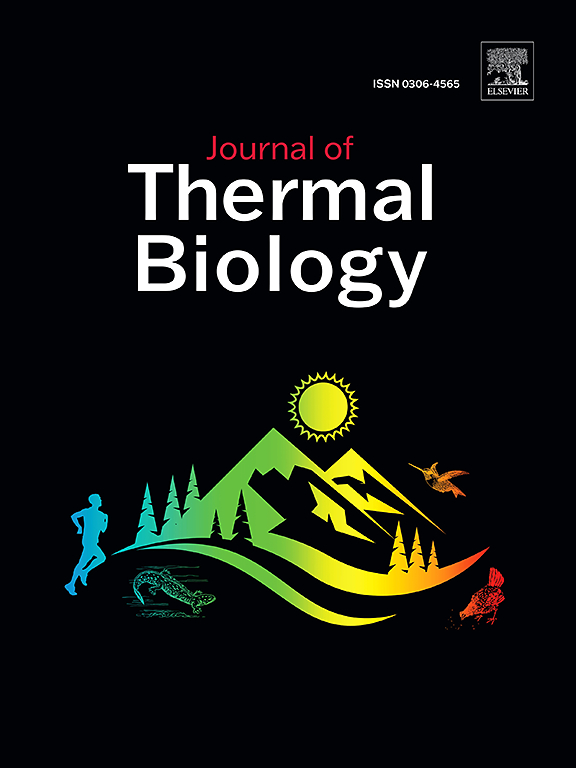Increased age and reduced physical activity level worsen thermoregulatory pacing behaviour in men during walking exercise in the heat
IF 2.9
2区 生物学
Q2 BIOLOGY
引用次数: 0
Abstract
Older adults are vulnerable to heat-related morbidity and mortality due to reduced thermoregulatory function associated with aging. The aim of this study was to examine the relationship between age and thermoregulatory behaviour during walking exercise in Control (22 °C; 40% relative humidity [RH]) and Hot (35 °C, 40% RH) conditions. Thirty-six healthy males (age 46 ± 20 (range 19–86) years; stature 177 ± 7 cm; body mass 75.7 ± 11.3 kg; BMI 24.2 ± 2.9 kg m−2; Ʃskinfolds 33.3 ± 10.5 mm; mean ± SD) each completed two experimental trials, one in Control and one in Hot conditions. Each trial consisted of three bouts of 10 min walking at a rating of perceived exertion (RPE) of 13, interspersed with 5 min of seated rest. Thermoregulatory behaviour was assessed as the ratio between distance walked in the Control and Hot trials. Participants walked 3.8% less in the Hot (2.63 ± 0.46 km) than in the Control (2.73 ± 0.4 km) condition (t(36) = −2.38, p = 0.023, d = 0.26). Regression analysis demonstrated that age was the primary predictor of thermoregulatory pacing behaviour, explaining 23% of the variance (Std β = −0.475, p = 0.003). Including physical activity levels (PASE) increased the variance accounted to 32% (age Std β = −0.396, p = 0.011; PASE Std β = 0.319, p = 0.038). In conclusion, thermoregulatory pacing behaviour was impaired with increased age and reduced physical activity when undertaking walking exercise at a perceived exertion of ‘somewhat hard’ in hot ambient conditions.
年龄的增加和运动量的减少会使男性在高温下进行步行运动时的体温调节起搏行为恶化。
由于与衰老相关的体温调节功能降低,老年人易患与热有关的发病率和死亡率。本研究的目的是研究年龄与对照组(22°C;40%相对湿度[RH])和高温(35℃,40% RH)条件。健康男性36例(年龄46±20岁,19 ~ 86岁);身高177±7cm;体重75.7±11.3 kg;BMI 24.2±2.9 kg m-2;Ʃskinfolds 33.3±10.5 mm;平均±SD)每人完成两个实验试验,一个在对照条件下,一个在高温条件下。每个试验包括三组10分钟的步行,感知运动(RPE)评分为13,穿插5分钟的坐姿休息。体温调节行为被评估为对照试验和热试验中行走距离的比值。热组(2.63±0.46公里)比对照组(2.73±0.4公里)少走3.8% (t(36) = -2.38, p = 0.023, d = 0.26)。回归分析表明,年龄是体温调节起搏行为的主要预测因子,解释了23%的方差(Std β = -0.475, p = 0.003)。包括体力活动水平(PASE)增加的方差占32%(年龄Std β = -0.396, p = 0.011;PASE Std β = 0.319, p = 0.038)。综上所述,当在炎热的环境条件下进行“有点硬”的步行运动时,随着年龄的增长和体力活动的减少,体温调节起搏行为会受到损害。
本文章由计算机程序翻译,如有差异,请以英文原文为准。
求助全文
约1分钟内获得全文
求助全文
来源期刊

Journal of thermal biology
生物-动物学
CiteScore
5.30
自引率
7.40%
发文量
196
审稿时长
14.5 weeks
期刊介绍:
The Journal of Thermal Biology publishes articles that advance our knowledge on the ways and mechanisms through which temperature affects man and animals. This includes studies of their responses to these effects and on the ecological consequences. Directly relevant to this theme are:
• The mechanisms of thermal limitation, heat and cold injury, and the resistance of organisms to extremes of temperature
• The mechanisms involved in acclimation, acclimatization and evolutionary adaptation to temperature
• Mechanisms underlying the patterns of hibernation, torpor, dormancy, aestivation and diapause
• Effects of temperature on reproduction and development, growth, ageing and life-span
• Studies on modelling heat transfer between organisms and their environment
• The contributions of temperature to effects of climate change on animal species and man
• Studies of conservation biology and physiology related to temperature
• Behavioural and physiological regulation of body temperature including its pathophysiology and fever
• Medical applications of hypo- and hyperthermia
Article types:
• Original articles
• Review articles
 求助内容:
求助内容: 应助结果提醒方式:
应助结果提醒方式:


